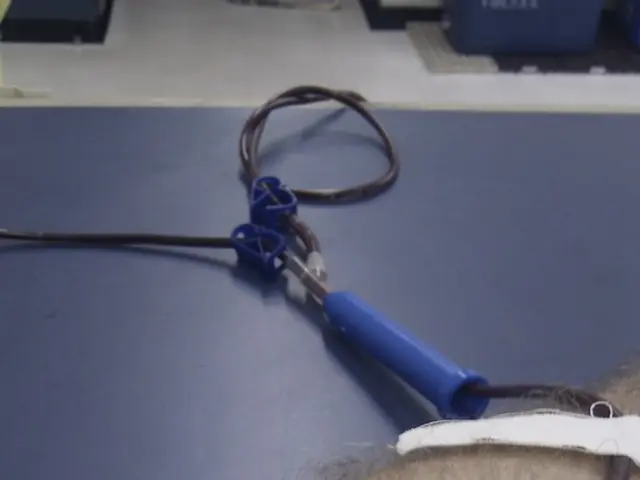Anticipated Healing Process after Hip Replacement: Understanding the Stages of Recovery
Hip Replacement Surgery Recovery Timeline: A Comprehensive Guide
Hip replacement surgery, whether partial or total, is a common orthopedic procedure designed to alleviate pain and improve mobility. The recovery period varies between individuals, but with careful adherence to post-operative care instructions, most patients can return to their daily activities within a few weeks to months.
Before the surgery, it is crucial to prepare oneself physically and emotionally. The American Academy of Orthopedic Surgeons (AAOS) advises that people should aim to resume independent daily living and light activities within three to six weeks of surgery. Pre-surgery preparations, such as discussing the surgery with medical professionals, performing leg-strengthening exercises, maintaining a moderate weight, quitting smoking, and arranging for post-operative assistance, play a significant role in the total recovery timeline.
In the days following the surgery, patients may remain in the hospital for one to two days or may choose to recover at home the same day as the procedure. Pain relief medications such as opioids, local anesthetics, nonsteroidal anti-inflammatory drugs (NSAIDs), and acetaminophen may be administered to manage discomfort. The surgical incision is stapled or stitched and typically heals within two weeks, requiring careful wound care at home. Early mobility is essential, and patients are encouraged to walk with assistance the day of the operation, although this may initially be painful or uncomfortable. A physiotherapist provides guidance on exercises to strengthen the leg and avoid damaging the new hip.
Upon returning home, patients may require assistance with daily tasks for several weeks or choose to undergo rehabilitation at a facility. During this stage, pain and discomfort persist for a few weeks, and prescription medications should be continued as instructed. Physical therapy or home exercises, as recommended by a physical therapist, aid in recovery, promoting flexibility and strength in the new joint. Home health aides, nurses, or physical therapists may also be needed to monitor progress and offer support. It is equally important to keep the surgery incision dry until it has fully healed, at which point stitches or staples may be removed.
By about 10 to 14 days post-surgery, the stitches are usually removed, and pain and swelling begin to subside for most patients. The level of activity during this stage varies from person to person, with some patients requiring a cane or walker for support.
Within three to six weeks, many patients can generally resume light activities of daily living, feeling stronger, more stable, and comfortable putting more weight on their leg. Return to work is usually possible after six weeks, while sexual activity may be resumed after six to eight weeks. Throughout this period, it is essential to continue physical therapy, as recommended by a medical professional, for at least two months. The doctor can also advise on when it is safe to engage in additional exercise, such as swimming and walking.
After three months, patients may be able to resume daily activities. It is advisable to consult a doctor regarding when to reduce or discontinue physical therapy and whether it is safe to engage in low-impact sports. Recovery progress should be evaluated by a doctor, and the best type of physical therapy to support the recovery process should be discussed.
Frequent tips for aiding recovery include following physical therapy exercises, taking gentle exercises like daily walking, avoiding prolonged periods of sitting or crossing the legs at the knee, and using a cold compress to reduce swelling. Intense exercise, heavy weightlifting, and moving or lifting heavy objects should be avoided.
Older and younger patients may experience different recovery patterns. In older adults, avoiding falls is crucial, and they may benefit from using walking aids, such as walkers, canes, or crutches, until they feel more stable. In patients under 20, recovery may be complicated by chronic conditions, although modern hip replacement implants show promising outcomes and survival rates in younger populations.
Hip resurfacing is an alternative to traditional hip replacement surgery, during which the femoral head is not removed but instead trimmed and capped with a metal cover. The majority of patients can go home within one to four days after hip resurfacing surgery. Walking aids may be necessary for the first few days or weeks while pain and discomfort subside. A doctor may prescribe medications for pain management, and physical therapy will be essential for recovery, focusing on improving range of motion and strength. Patients can typically resume their regular activities around six weeks after surgery.
• follow physical therapy exercises as a physical therapist instructs• try other gentle exercises, such as daily walking• sit in a reclining position• use a cold compress to reduce swelling• take any prescription medications as a doctor instructs• use walking aids, such as crutches, if necessary
Overall, the typical timeline for resuming normal activities and returning to work after hip replacement surgery is as follows:
- Immediate Post-Op (Day 0–2): Hospital stay, initial walking, and pain management
- Early Recovery (Weeks 1–2): Rest, incision healing, basic mobility, possibly light work for sedentary jobs
- Strength and Mobility Building (Weeks 2–6): Physical therapy, gradual increase in activity
- Return to Work & Low-Impact Sports (Weeks 6–12): Return to work (office or light duties), low-impact sports like swimming and cycling
- Full Recovery (Up to 12 Months): Complete healing, cautious return to higher-impact activities, full function restoration
• sitting still for long periods• crossing the legs at the knee• bending the hip more than 90 degrees• bending down to touch the feet or ankles• sitting in low chairs• intense exercise, which may involve jumping or sudden turns• moving or lifting heavy objects
With careful adherence to post-operative care instructions and a positive attitude, patients can successfully recover from hip replacement surgery, resuming their daily activities and enjoying improved mobility and a better quality of life.
Colitis and ulcerative diseases could require special attention during the recovery process, as certain medications used in hip replacement surgery might affect the digestive system. Science and medical-conditions research are essential to understand potential interactions.
In the context of chronic diseases like Alzheimer's, COPD, obesity, chronic kidney disease, and mental health, it's crucial to ensure adequate pre-operative and post-operative care to minimize complications and enable a smooth recovery. Adequate nutrition and fitness-and-exercise routines are essential components of overall wellness before and after the surgery.
While aging is an inherent part of life, it is essential to consider the potential impact on recovery time. The use of CBD products for pain management may serve as an alternative to opioids, especially in cases of prolonged usage to mitigate discomfort during recovery.
AQ technology can help monitor patients remotely, ensuring adherence to prescribed physical therapy exercises and providing regular updates to healthcare professionals. This could prove particularly beneficial for older adults, who may require more support and monitoring during the recovery period.
Physical therapy plays a significant role in recovery, with a focus on building strength and mobility in the new hip joint and addressing any underlying physical challenges. Ina younger patient population, chronic diseases may present added complexities to the recovery timeline, necessitating a more tailored approach to rehabilitation.
When evaluating the recovery process, it's essential to consider not only the physical aspects but also the mental health aspect. Patients should be encouraged to adopt a positive attitude and active engagement in their recovery journey, as mental well-being can significantly impact the overall outcome.
Lastly, maintaining a balanced diet during the recovery period, focusing on nutrient-dense foods, is crucial to support the healing process and prevent potential complications. This holistic approach to health and wellness will enable patients to return to their daily activities with improved mobility and a better quality of life.








